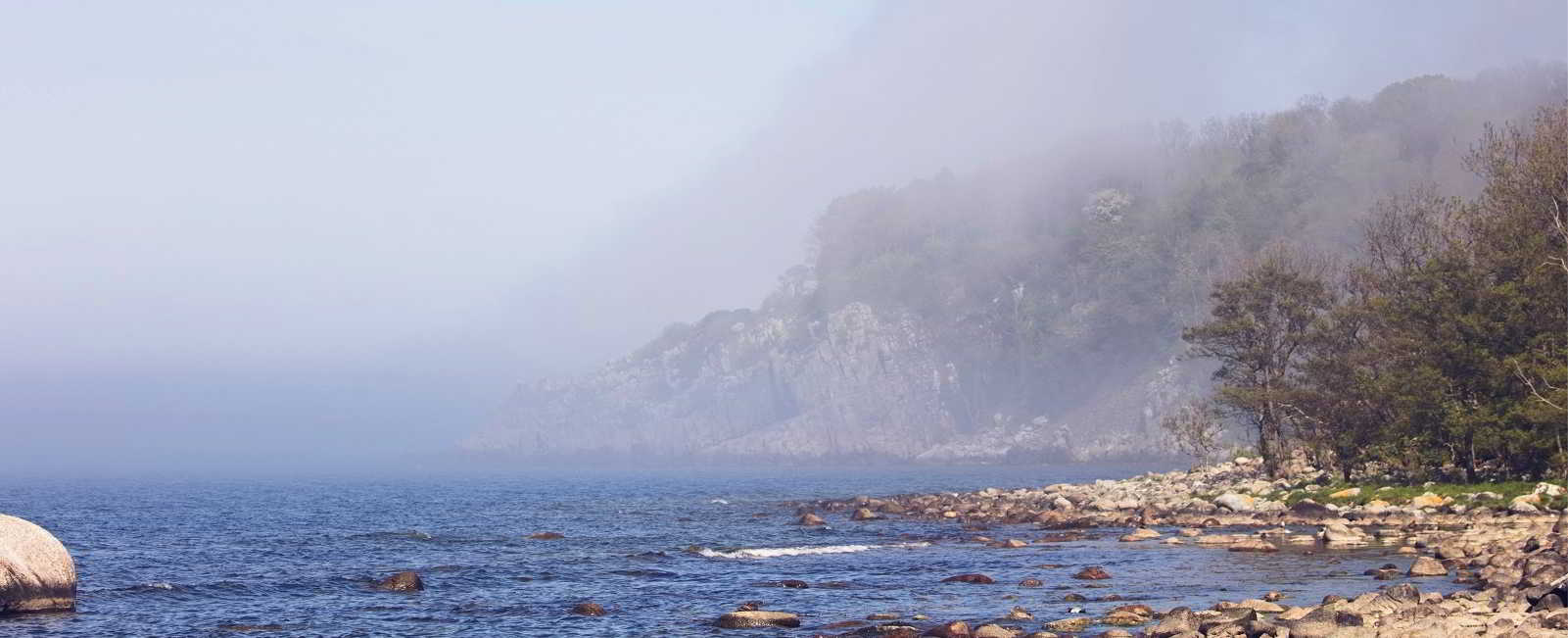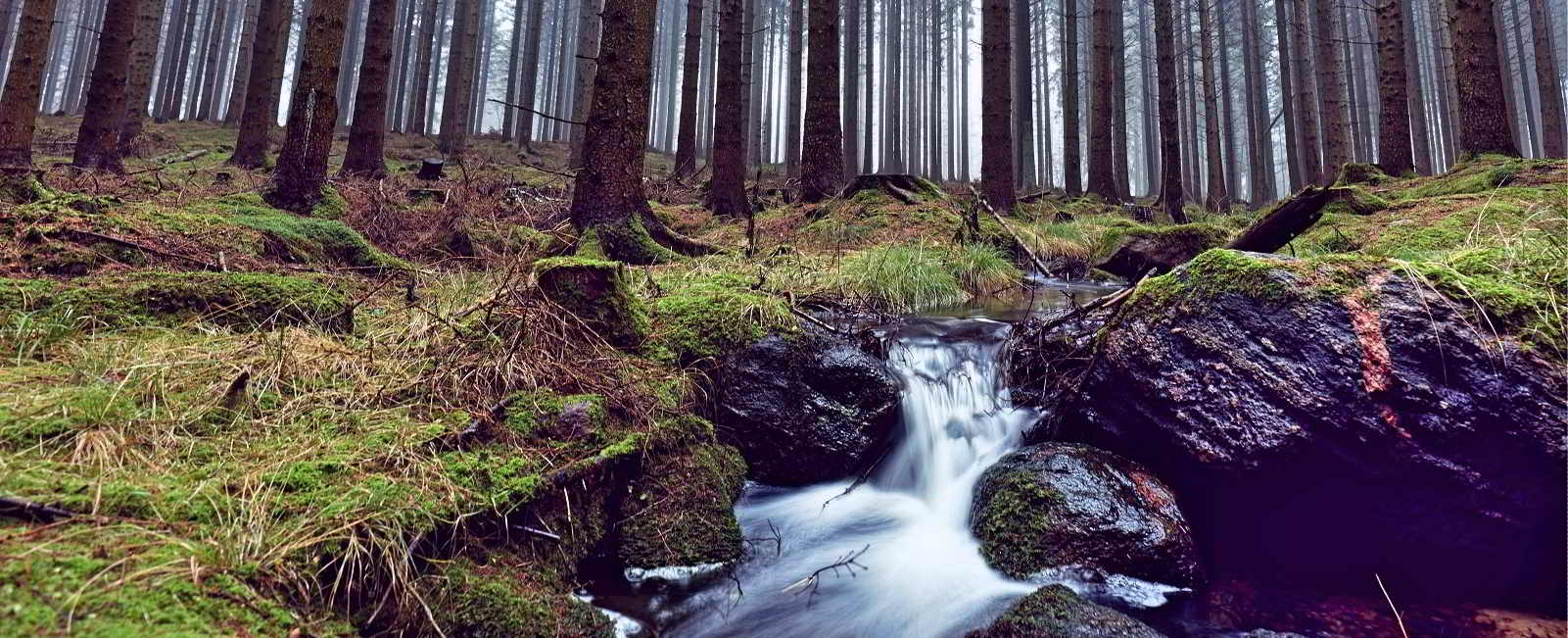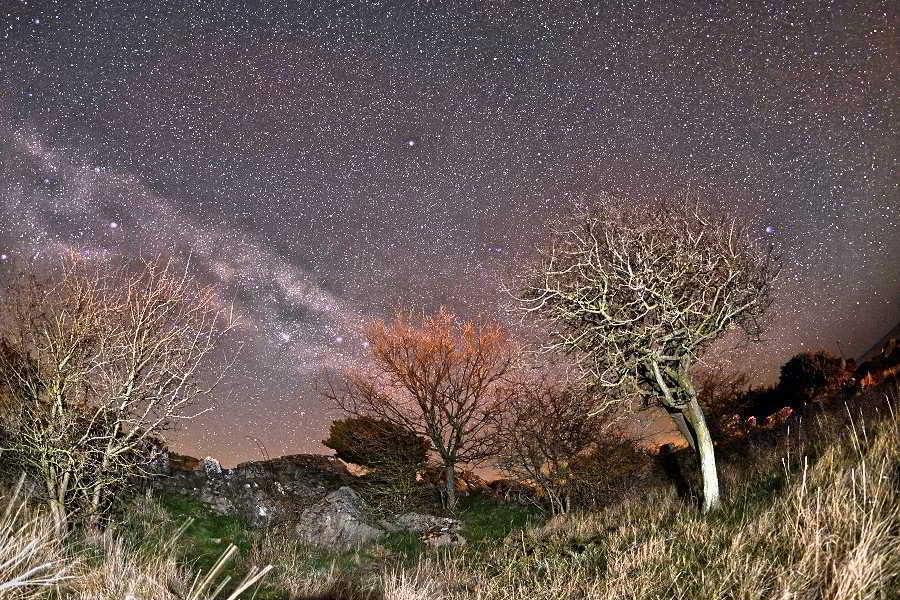Almindingen forest
In the centre of Bornholm
Almindingen is one of the largest forests in Denmark. Almindingen is a large forest area with three-peat bogs, which is one of the best wetlands on Bornholm, with a variety of birds. The area includes both coniferous and deciduous forests and several forest lakes. The largest bogs are Ølene, Bastemose and Svinemose. Ølene is a wetland with a shallow lake, old peat ponds, and extensive meadows. Bastemose is overgrown with rushes and willow thickets. Svinemose is mainly a peat bog with rushes. Several areas in Almindingen are preserved as 'untouched' woodland and pasture. In the eastern part, there are a few open heathlands.
Breeding birds:
Bornholm has long been known as the only breeding site for the woolly warbler in Denmark and is the first place in the country to breed the black woodpecker. There are many other breeding birds in Almindingen, for example, cranes and the marsh harrier, which makes the area very interesting. In the forest, you will encounter cranes, honeycreepers, hawks, woodcock, woodlarks, pipits, and creepers as well as more common forest birds.
Migratory birds:
Many birds of prey visit the moors during the migration period, e.g. harrier, hawk, sparrowhawk, buzzard, osprey, kestrel, and falcon. At Ølene we have a good chance of seeing the white-tailed eagle and the golden eagle, which appears during the winter months.
Various wading birds visit Ølene during the migration period - mute swan, whooper swan, and greylag use the marshes as wintering grounds. Udkæret, south of Almindingen is an important stopping place for cranes, waders, geese, and ducks.
Other animals:
Bornholm has a large population of roe deer, which were reintroduced to the island in 1885. It is interesting to note that there are no foxes, martens, or moles on Bornholm. In 2012, a group of bison (the largest wild mammal in Europe today) was introduced to the area south of Rømersvej. Bison are wild animals native to Poland. Seeing these large animals in the middle of Almindingen is a fantastic experience if we are lucky enough to spot them. We have to move very quietly in order to get close to them. If a bison feels threatened, it moves away into the forest - which visitors should respect. The bison have already adapted to the area in the best possible way and can occasionally be seen crossing Chr. X Vej during the day.
Most of the area is easily accessible as Almindingen is crossed by many public roads. Many car parks and picnic areas offer good starting points for walks in the area. There are three birdwatching towers in Ølene, the newest of which on Rømersvej is wheelchair accessible.
In Bastemosen there is a 5 m high observation tower with a ramp that is wheelchair accessible. Svinemosen also has an observation tower. A new tower at Kærgårds-Vallensgårdsmose, accessible from Skørrebrova, provides a good view of the bog. There are many lookout towers in the Almindingen forest, including Ryttergnagten, the highest on the island, which offers a view of the whole island. Our guide will point out and help us with places worth capturing.
Dueodde
The southernmost tip of Bornholm
Dueodde is a sandy beach, which in some places is up to 100 meters wide. Behind the beach is an area with shifting sand and dunes, and further inland is Strandmarken, a large plantation established in the 1870s. It consists mainly of mountain pine and Scots pine. There are many holiday cottages on the plantation. Near the southernmost tip of the spit is the 47 m high Dueodde lighthouse.
Migratory birds:
The bird migration starts in August when swallows and a few birds of prey begin their journey south. In September, migrating larks, pipits, wagtails, thrushes, pipits, tits, and siskins appear, as well as large flocks of finches and blackbirds. Finches and siskins migrate until October when there is also a chance to see flocks of migrating cranes. The record is 7,000 in one day.
Seabirds move along the coast in great numbers, gulls are regularly seen here, and we can also see divers, cormorants, widgeon, tufted ducks, and wigeon. Geese also fly along the coast, and sometimes hundreds of white-fronted and barnacle geese can be seen.
On Søndre Landevej between Rønne and Snogebæk there are signposts leading to Dueodde. From the road connecting Pedersker, Dueodde and Snogebæk there are several smaller roads leading to car parks near the coast.
A disabled-friendly promenade leads from the small shops in Dueodde to the sea. The best place for photography is on the dunes, where you can shelter from the wind and enjoy a beautiful view both inland and out to sea. From the observation deck of Dueodde lighthouse, you can also take a series of unique shots of nature.

Ertholmene
An archipelago to the northeast of Bornholm
The two largest islands in the Ertholmene archipelago, Christiansø, and Frederiksø, are inhabited. Christiansø is 710 m long and 430 m wide and is surrounded by 300-year-old defensive walls from the time when the island was of military importance. Most of the buildings are grouped together in the harbor. There is a group of tall trees and shrubs in the middle of the island, but otherwise, the vegetation is sparse, with small heath and a few small ponds and reed beds. The third island in the archipelago, Græsholm, which has almost no vegetation, is a bird reserve. Because the islands are small and isolated, they do not harbor any indigenous land mammals.
In the 19th century, seals were common on the islands, but in the early 20th century they were hunted, resulting in their near extinction, both on Christiansø and on Bornholm itself. Fortunately, the grey seal has made a comeback in recent years. With 400 resting grey seals, Ertholmene is now one of the largest resting places for this large seal.
Animal life on the islands is mainly concentrated around water holes and ponds. The loudest animal is the marsh frog, but it is very difficult to spot. Rain brings out all the toads, so be careful where you step. Other amphibians include small newts and the green toad. There are not many mammals on Ertholmene, but there is still a small colony of hedgehogs that were released on the islands in the 1950s.
The Ertholmene archipelago is also a reserve for Nordic bees. This is an old species of honeybee that until about 170 years ago was the only type of honeybee north of the Alps. In Denmark, this old species is only found on the islands of Læsø, Endelave, Anholt, and Ertholmene. The Nordic honeybee develops at lower temperatures than other bee species. This means that they do not need as much winter food and endure the winter better. The islanders love their bees. They say that thanks to pollination by bees, they harvest ten times more strawberries and apples than when there were no bees. Bees also improve the pollination of many wildflowers and flowering plants, producing more seeds and berries for the many migratory birds on the islands.
Breeding birds:
The islands are an important breeding site for the alka and the nuit. Denmark's only colonies of boink (2,500-3,000 pairs) and alka (1,000 pairs) are on Græsholm, where there is also a large colony of silvery gull (about 8,000 pairs). Small numbers of common gull, black-backed gull, and great-necked gull nest on the islands.
Migratory birds:
Being a small group of islands far out to sea, Ertholmene is a typical place that attracts migrating birds. Spring migration peaks in April and May, and autumn migration is in full swing from late July to around November. In autumn, cranes fly over the islands (sometimes as many as 6000-7000 birds).
Other animals:
The number of grey seals observed around Ertholmene has increased significantly since 2007. They can mainly be seen near Skerra Tat north of Græsholm, but sometimes approach the coast of inhabited islands. Most grey seals occur in April/May. The small ponds scattered around the island, which are used to collect rainwater, are home to four species of amphibians: the grey toad, the green toad, the marsh frog, and the newt.
During the summer months (early May to late September) there is a ferry from Gudhjem to the island of Christiansø. Taking the first ferry from Bornholm in the morning and the last ferry from Christiansø in the evening, you can spend several hours on the island observing the flora and fauna. We can arrange to go and get to the archipelago by boat or rib together with our photographer, allowing us to get closer to Graesholmen, time-independent. However, spending the night on the island and enjoying the peace and quiet is also an exciting experience. It does require planning though, as there is only one inn and a very small camping area on the island, so reservations need to be made well in advance. The Lilletårn tower on Frederiksø houses a natural history exhibition with an emphasis on birds. Walking is allowed on Christiansø and Frederiksø, but it is better to stick to the paths. The island of Græsholm is under protection and access is prohibited. However, north of Lilletårnet on Frederiksø you can easily see the island of Græsholm.

Hammeren and Slotslyngen
Northern Bornholm
Hammeren is the northernmost point on Bornholm. It is a huge rocky outcrop smoothed by glaciers of the last ice age, separated from the rest of the island by a rift valley in which Bornholm's largest lake, Hammersø, is located. The area is mostly heathland with sparse shrubs and low trees. The vegetation is limited by sheep grazing. To the south is Slotslyngen heath: originally only heather grew here, but now some tree species are also growing. The terrain is very hilly and consists of rift valleys, cliffs, and marshes. The southern part is dry meadows and heathland grazed by sheep and cattle. The coast is formed by steep cliffs. This is the best place on Bornholm because of the spring migration and the only bird cliffs in Denmark.
Breeding birds:
Hammeren is one of the first places in Denmark where the peregrine falcon started breeding again after many years of absence. It started nesting on the cliffs at Slotslyngen in 2006. The cliffs are also a breeding ground for silverback gull, jackdaw, starling, and several pairs of Baltic black-backed gull. In the woodlands, we can see all the common woodland birds as well as some rarer species such as buzzard, hawk, sparrowhawk, woodcock, raven, whooping woodpecker, bluebird, and greater scaup.
Migratory birds:
Most birdwatchers come to this site to see the spring migration when large flocks of birds fly over on their way to breeding grounds further north. Rare species native to the eastern regions can be found among the migrating and stationing birds. Several rare species are observed almost every year, for example, the red-breasted flycatcher and the scarlet azalea. The migration of birds of prey is on a smaller scale and mainly includes buzzards and sparrowhawks, but occasionally a rarer species appears.
Spring migration can be observed here from several locations. The marine migration can best be seen from the outermost point, Hammer Odde, northwest of the lighthouse. The migration of birds of prey can be observed from Hjortebjerg, the highest point of Hammeren, near the car park north of Sandvig. To reach the car park, turn off Strandgade in the middle of the village and continue along Sandlinien, past the campsite and along the bay. The car park is at the end of the road. From here, a tarmac road leads to the lighthouse or you can walk up the hills on the path leading from the car park. There are open spaces around Hammerfyr (the lighthouse at the southern end of Hammeren) from where you can also watch the migration. It can be reached by turning off Hammershusvej at the southwestern end of Sandvig and driving along Hammersøvej towards the lighthouse. A little further south of Slotslyngen are the largest castle ruins in northern Europe, Hammershus. The area around the castle has great views to offer us, both from the castle ruins and from the foot of the castle. The best way to get to Slotslyngen is to park at Finnedalsvejen, half a kilometre north of Vang. The walk here is very impressive, with the bare cliffs on the right and a wonderful view of the Baltic Sea on the left. The view of the cliffs from the sea is also an incredible experience, which can be arranged with a boat service in Hammerhavn.

The richness of the flora and fauna, the amazing landscapes, and the natural beauty on Bornholm, let us capture it all in a photograph. Our guide is Bornholm nature photographer Mikkel Due Andersen, who shows us the most beautiful and interesting places on Bornholm and shares his knowledge about photography. Contact us and experience an unforgettable holiday on Bornholm.
Do you want to know about our other exciting activity holidays on Bornholm?
See what else you might be interested in. Discover the mystery of this sunny island. Yes, Bornholm is closer than you think...
Bornholm is located in the middle of the Baltic Sea and is sparsely populated, so there is little so-called 'light field'. Of course, the best time to go stargazing is in the autumn and winter, when the days are shorter and Bornholm has fewer tourists and less light, so the sky is even more visible.
This trip is the pleasure of foreign travel, combined with photography. The project is intended for tourists and photography enthusiasts of all levels of experience.











